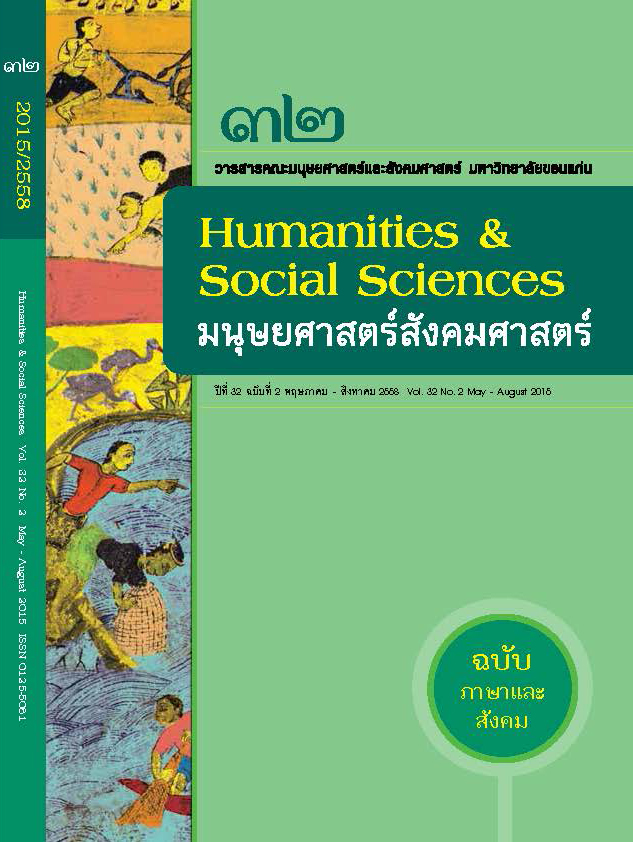“Yes, We Fully Realize That We’re Watching a Play. We Just Don’t Realize That It’s Brecht.”: An Analysis of Brecht’s V-effect Technique Used in Thai Likay Theatre
Keywords:
Theatre, Drama, Performance, Comparative theatre studies, Verfremdungseffekt, V-effect, Epic Theatre, Brechtian dramatic techniques, Likay TheatreAbstract
“Yes, We Fully Realize That We’re Watching a Play. We Just Don’t Realize That It’s Brecht.”: An Analysis of Brecht’s V-effect Technique Used in Thai Likay Theatre
บทคัดย่อ
แบร์ทอลท์ เบรคชท์ นักการละครเลื่องชื่อชาวเยอรมันได้นำเสนอรูปแบบการแสดงที่เรียกว่า ‘Epic Theatre’ ในช่วงกลางศตวรรษที่ 20 และนำเสนอรูปแบบการแสดงที่เรียกว่า “การทำให้แปลก”(Verfremdungeffecks หรือ V-effect) โดยเป็นรูปแบบการแสดงที่สร้างสรรค์ขึ้นเพื่อต่อต้านการแสดงแนวสมจริงหรือธรรมชาตินิยมที่เป็นที่นิยมกันทั่วไปในแวดวงการละครตะวันตก จุดประสงค์หลักของการ “ทำให้แปลก” นี้ ก็เพื่อให้ผู้ชมตระหนักอยู่ตลอดเวลาว่ากำลังชมละครอยู่ เพื่อที่ผู้ชมจะได้ไม่ถูกดึงเข้าไปในโลกมายาแห่งละครอย่างเต็มที่จนกระทั่งหลงลืมใจความหลักที่ละครต้องการจะสื่อ และเพื่อที่ผู้ชมจะได้ใช้ปัญญาเพื่อพิจารณาและทำความเข้าใจกับเนื้อหาและจุดประสงค์หลักของละครในระหว่างที่ชมการแสดง เทคนิคดังกล่าวประกอบไปด้วยการทำลาย “กำแพงที่สี่” โดยให้นักแสดงออกมาจากการเป็นตัวละคร การให้นักแสดงพูดกับผู้ชมได้โดยตรง การให้นักแสดงหนึ่งคนสามารถเปลี่ยนบทบาทเป็นตัวละครหลายตัว การใช้อุปกรณ์ประกอบฉากแบบแสดงสัญลักษณ์ การใช้ฉากที่ไม่สมจริงและสามารถปรับเปลี่ยนได้ต่อหน้าผู้ชม เป็นต้น
ลิเกคือการแสดงพื้นบ้านยอดนิยมของไทย อันมีส่วนประกอบที่หลากหลายทั้งบทพูด บทร้อง การด้นสด การร่ายรำ โดยมีการบรรเลงดนตรีสดของวงปี่พาทย์ประกอบตลอดการแสดง การแสดงลิเกของไทยได้รับการสืบทอดมาอย่างยาวนานของกว่าศตวรรษ แม้ว่านักแสดงลิเกจะไม่ได้ความรู้เรื่องเทคนิคการแสดงแบบ “ทำให้แปลก” ของแบร์ทอลท์ เบรคชท์หรือทฤษฎีการละครใดๆของโลกตะวันตก แต่กลับพบว่าวิธีการแสดงลิเกของไทยกลับมีส่วนคล้ายคลึงกับ V-effect ของเบรคชท์เป็นอย่างมาก แม้ว่าจุดประสงค์หลักของการใช้เทคนิค “การทำให้แปลก” ที่พบในการแสดงลิเกไทยจะแตกต่างจากการละครในโลกตะวันตกก็ตาม บทความชิ้นนี้มีจุดประสงค์เพื่อจะแสดงตัวอย่างและอภิปรายโดยการใช้เทคนิค “การทำให้แปลก” ของแบร์ทอลท์ เบรคชท์ เป็นกรอบความคิดในการอภิปรายรูปแบบการแสดงที่พบในการแสดงลิเกของไทย
คำสำคัญ: การละคร, การแสดง, การละครเปรียบเทียบ, Verfremdungseffekt, V-effect, Epic Theatre, เทคนิคการแสดงแบบเบรคชท์, การแสดงลิเก
Abstract
Bertolt Brecht, a German theatre practitioner in the mid- 20th century, marked the success of his career by introducing his ‘Epic Theatre’ with the use of a dramatic technique called ‘Verfremdungeffecks’ ( V-effect), or ‘alienation effect’. ‘Brechtian’ acting style, which has been developed, practiced and popularized worldwide for decades, was a reaction against the most popular forms of theatre and naturalistic acting. The highest goal for using the alienation effect (V-effect) is to make the audience always realize that they are watching a play; they will never be “taken out of themselves” or immerse themselves so completely into the illusion of the drama, that they may be distracted from the main content of the story. The expected outcome for using V-effect is that the audience can reach an intellectual level of understanding of the play. Some Brechtian techniques include ‘breaking the fourth wall’ by having actors come out of their characters and address the audience directly, having actors play multiple roles, using some symbolic ornaments to represent actual props, or using non-realistic scenic design which can be conveniently rearranged by actors in full view of the audience -- just to name a few.
Likay, though generally categorized as a low form of theatre viewed by local Thai audiences, has been one of the most popular and traditional Thai theatre forms for centuries. Likay includes a mixture of performance styles comprising spoken improvisation, singing, dancing and natural acting, supported by a live classical music band. Having been performed for successive generations without any background knowledge related to Brecht’s V-effect or any western theatre theories, Likay has nonetheless strictly followed the rules of its traditional acting styles which, coincidently, are very much similar to Brecht’s V-effect. The conclusion can be drawn that even though Thai Likay is performed in a way as if the V-effect is fully adopted, the main difference may lie in the highest goal to be achieved by these two types of performances (Brecht’s epic theatre and Thai Likay).
Keywords: Theatre, Drama, Performance, Comparative theatre studies, Verfremdungseffekt, V-effect, Epic Theatre, Brechtian dramatic techniques, Likay Theatre



